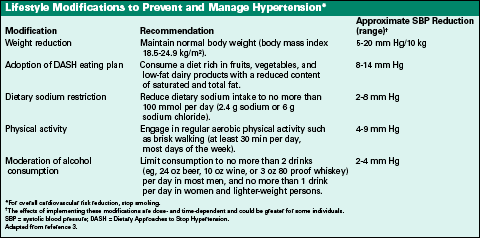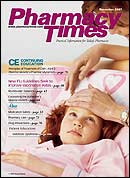Publication
Article
Pharmacy Times
Helping Patients Manage Cardiovascular Disease
Author(s):
Adherence to medications can aid in preventing and treating CVD.
Drs. Menefee and Knox are PharmDresidents, and Dr. Sherman is anassociate professor of pharmacypractice, at the University ofLouisiana at Monroe College ofPharmacy.
More than 1.4 million Americansdie of cardiovascular diseaseeach year, which is 1 deathevery 36 seconds, and more than 79 millionAmericans currently live with a cardiovasculardisease, including hypertension,coronary artery disease, heart failure,myocardial infarction, and stroke.1 Inaddition to certain lifestyle factors, suchas diet and exercise, diabetes mellitus isespecially important when looking atincreased risk of target-organ damagecaused by cardiovascular disease.
Risk Factors for Cardiovascular Disease
Common risk factors for cardiovasculardisease include the following: age >65years, male, genetic predisposition,African American race, smoking, highcholesterol, high blood pressure, physicalinactivity, overweight, and diabetes.Smoking, diet, blood pressure, and diabetesare modifiable risks, while race,age, and genetics are not. Risk increasesproportionally with the number of riskfactors. Two major independent risk factorsare high blood pressure and highblood cholesterol. A 10% decrease intotal cholesterol levels in the US populationoverall, for example, may result in anestimated 30% reduction in the incidenceof coronary heart disease.1 Thus,community pharmacists should encouragereducing modifiable risk factors.
Reducing Modifiable Risk
Long-standing hypertension, uncontrolleddiabetes, and high cholesterolcan lead to many complications, suchas kidney damage, heart attack, stroke,limb amputation, and blindness. Animportant consideration in cardiovasculardisease is that many complicationscan occur together and lead toothers. Education and prevention providepharmacists with an importantopportunity to help patients reducetheir risk of cardiovascular events.2
Resources for Lifestyle Modifications for Cardiovascular Disease
www.nhlbi.nih.gov/chd
www.nhlbi.nih.gov/subsites/index.htm
click healthy weight
www.nhlbi.nih.gov/hbp
www.nutrition.gov
www.fitness.gov
www.cdc.gov/tobacco
According to theSeventh Report of theJoint National Committeeon Prevention,Detection, Evaluation,and Treatment of HighBlood Pressure (JNC 7),the American HeartAssociation Guidelines,and the NationalCholesterol EducationProgram Adult TreatmentPanel III (NCEP/ATP III), a nutritiousdiet helps to reduceoccurrence of cardiovasculardisease.Heart failure, hypertension,stroke, andmyocardial infarctionrisk can be decreasedwith weight reduction, smoking cessation,and increased physical activity.3-5Teaching patients how to read foodlabels, choose alternative salt and sugarsources, and participate in local fitnessprograms could have a major impact ontheir health care. Eliminating sodas, highfructose fruit drinks, bread, and table saltand simply walking for 30 minutes a dayin 10-minute blocks could help withweight, blood pressure, and cholesterolreduction. The benefits of lowering bloodpressure alone equal a 40% reduction instroke occurrence, a 25% decrease inmyocardial infarction, and a 50% decreasein heart failure.6
To help reduce cardiovascular disease,pharmacists should encouragemodest weight reduction (approximately10%); a diet rich in fruits, vegetables,and low-fat dairy products; reducedsodium (≤2.4 g per day); limitedalcohol consumption; smoking cessation;and increased physical activity(Table 1). To maximize the reduction oflow-density lipoprotein (LDL) cholesterolthrough diet, NCEP?s TherapeuticLifestyle Change (TLC) Diet recommendsconsumption of <200 mg ofcholesterol per day.5 Although manypatients expect medications to be thecure-all, they are not; rather, theyshould be used along with lifestylemodifications for optimal results.
Table 1

Medication Management
Pharmacists can have a tremendousimpact on the treatment of cardiovasculardisease. Adherence to evidencebasedtherapies and risk-factor managementimproves cardiac-patient survivaland quality of life.7 Angiotensin-convertingenzyme inhibitors (ACEIs) are effectivein the treatment and prevention ofmany cardiovascular events. An ACEI oran angiotensin receptor blocker (ARB)should be prescribed to all patients withleft ventricular dysfunction (heart failure)and/or post myocardial infarction.7Clinical trials have demonstrated thebenefits of antiplatelet, beta-adrenergicblocker (BB), ACEI, and statin therapy incardiovascular disease.1 According to theAmerican Diabetes Association guidelines,aspirin as a primary and secondarytherapy prevents cardiovascular eventsin diabetic and nondiabetic individuals.4
Nearly 1 in 3 adults in the UnitedStates has high blood pressure. For each20-mm increase in systolic readings and10-mm increase in diastolic above115/75 mm Hg, there is a twofold increasein cardiovascular disease.6Recommended medication therapies forhypertension and other cardiovascularcomorbidities from the JNC 7 are listed inTable 2.
Table 2

Pharmacists also should remind patientsto stay current with their vaccinationsand have blood pressure, blood glucose,and cholesterol levels checked routinely.Influenza vaccine has been shownto reduce diabetes-related hospitaladmission by as much as 79% during fluepidemics. Also, tight glycemic controlhelps to delay or diminish microvascularcomplications.4 Reduced blood pressureand cholesterol decrease morbidity andmortality for patients with hypertensionand hyperlipidemia, respectively. Preventionis the best means of treatmentfor cardiovascular disease.
Conclusion
Compliance and creating the idealenvironment for medications to workcan help prevent and treat cardiovasculardisease. Inform patients of the importanceof taking their medications asdirected. Although many patients expecta quick fix at the doctor?s office or neighborhoodpharmacy, encourage them totake responsibility for their own healthcare and make this a priority. Exercising,eating right, and following their prescribedtreatment regimens are for theirown benefit.
References
- Centers for Disease Control and Prevention. Division for Heart Disease and Stroke Prevention. Addressing the Nation's Leading Killers-At a Glance 2007. Available at: www.cdc.gov/nccdphp/publications/AAG/dhdsp.htm.
- American Heart Association. Risk Factors and Coronary Heart Disease. Available at: www.americanheart.org/presenter.jhtml?identifier=4726.
- National Heart Lung and Blood Institute. The Seventh Report of the Joint National Committee on Prevention, Detection, Evaluation, and Treatment of High Blood Pressure. Available at: www.nhlbi.nih.gov/guidelines/hypertension/jnc7full.htm.
- American Diabetes Association. Standards of Medical Care in Diabetes-2007. Diabetes Care. 2007;30(suppl):S4-S33.
- National Heart Lung and Blood Institute. Third Report of the Expert Panel on the Detection, Evaluation, and Treatment of High Blood Cholesterol in Adults (Adult Treatment Panel III): Executive Summary. Available at: www.nhlbi.nih.gov/guidelines/cholesterol/atp_iii.htm.
- Spencer AP. Outpatient Cardiology. In: Updates in Therapeutics: The Pharmacotherapy Preparatory Course. American College of Clinical Pharmacy; 2007:581-607.
- Hertz KT. The continuum of cardiovascular care: championing guideline adherence, optimizing the "teachable moment." Physicians Weekly. June 21, 2004. Available at: www.physiciansweekly.com/index.asp?issueid=143.







